MITSUBISHI SHOGUN 2008 Owner's Manual (in English)
Manufacturer: MITSUBISHI, Model Year: 2008, Model line: SHOGUN, Model: MITSUBISHI SHOGUN 2008Pages: 538, PDF Size: 25.09 MB
Page 111 of 538
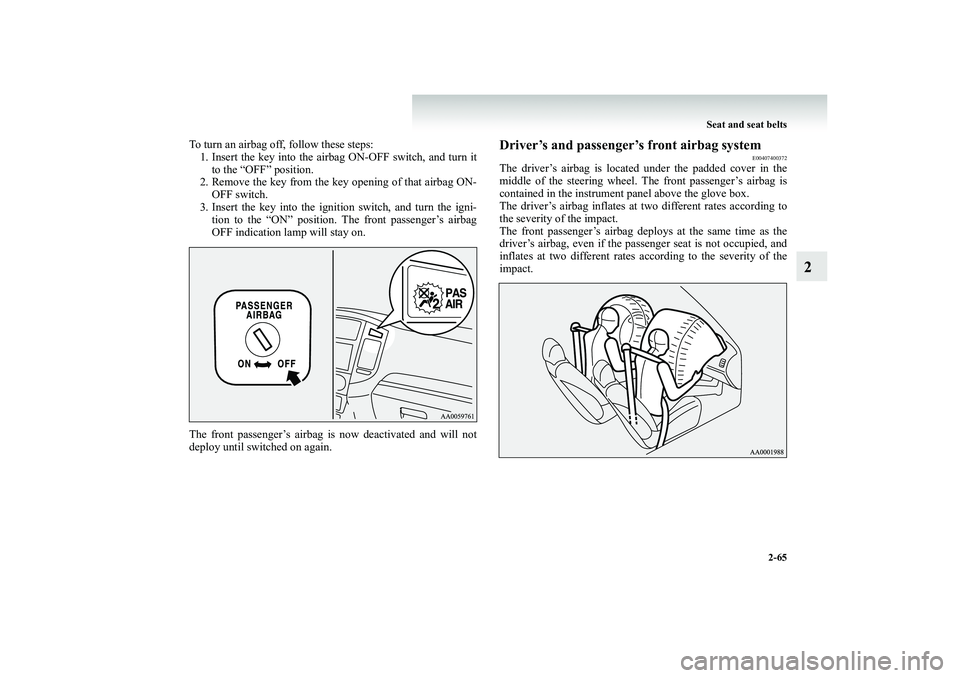
Seat and seat belts
2-65
2
To turn an airbag off, follow these steps: 1. Insert the key into the airbag ON-OFF switch, and turn it
to the “OFF” position.
2. Remove the key from the key opening of that airbag ON-
OFF switch.
3. Insert the key into the ignition switch, and turn the igni-
tion to the “ON” position. The front passenger’s airbagOFF indication lamp will stay on.
The front passenger’s airbag is
now deactivated and will not
deploy until switched on again.
Driver’s and passenger’s front airbag system
E00407400372
The driver’s airbag is located
under the padded cover in the
middle of the steering wheel. Th
e front passenger’s airbag is
contained in the instrument panel above the glove box. The driver’s airbag inflates at
two different rates according to
the severity of the impact. The front passenger’s airbag de
ploys at the same time as the
driver’s airbag, even if the passe
nger seat is not occupied, and
inflates at two different rates
according to the severity of the
impact.
BK-BK2008E1ENUK.en-uk-Section5.fm Page
65 Wednesday, January 9, 2008 4:28 PM
Page 112 of 538
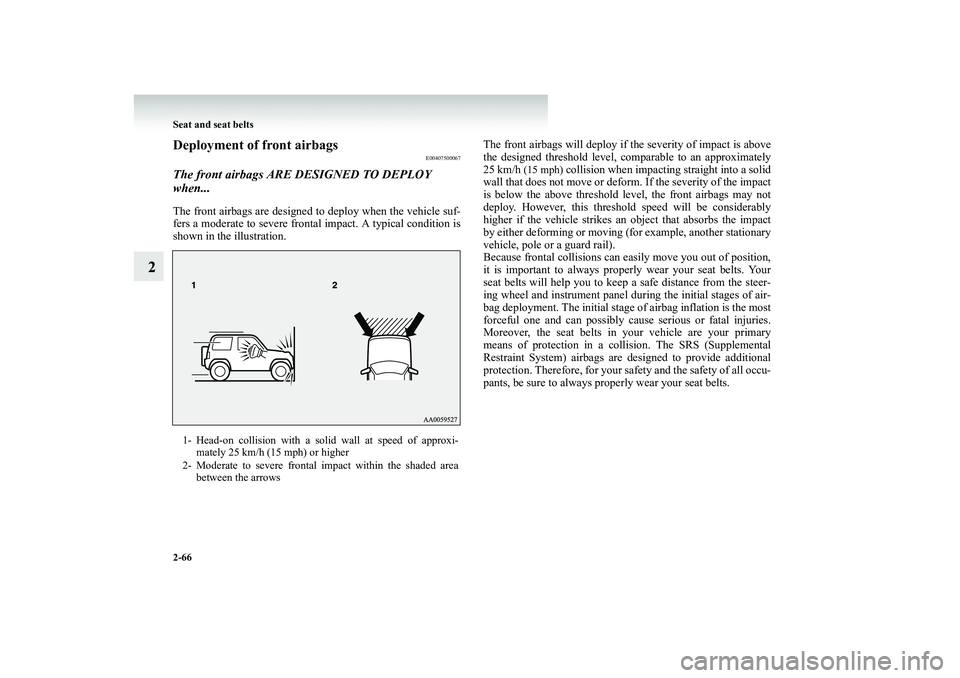
2-66 Seat and seat belts
2
Deployment of front airbags
E00407500067
The front airbags ARE DESIGNED TO DEPLOY when...The front airbags are designed
to deploy when the vehicle suf-
fers a moderate to severe frontal impact. A typical condition is shown in the illustration.
The front airbags will deploy if the severity of impact is above the designed threshold level, co
mparable to an approximately
25 km/h
(15 mph)
collision when impacting straight into a solid
wall that does not move or deform. If the severity of the impactis below the above threshold level, the front airbags may not deploy. However, this threshold speed will be considerably higher if the vehicle strikes an
object that absorbs the impact
by either deforming or moving (for example, another stationary vehicle, pole or a guard rail). Because frontal collisions can
easily move you out of position,
it is important to always properl
y wear your seat belts. Your
seat belts will help you to keep
a safe distance from the steer-
ing wheel and instrument panel during the initial stages of air-bag deployment. The initial stage of airbag inflation is the most forceful one and can possibly ca
use serious or fatal injuries.
Moreover, the seat belts in
your vehicle are your primary
means of protection in a col
lision. The SRS (Supplemental
Restraint System) airbags are de
signed to provide additional
protection. Therefore, for your sa
fety and the safety of all occu-
pants, be sure to always properly wear your seat belts.
1- Head-on collision with a solid wall at speed of approxi-
mately 25 km/h (15 mph) or higher
2- Moderate to severe frontal impact within the shaded area
between the arrows
BK-BK2008E1ENUK.en-uk-Section5.fm Page
66 Wednesday, January 9, 2008 4:28 PM
Page 113 of 538
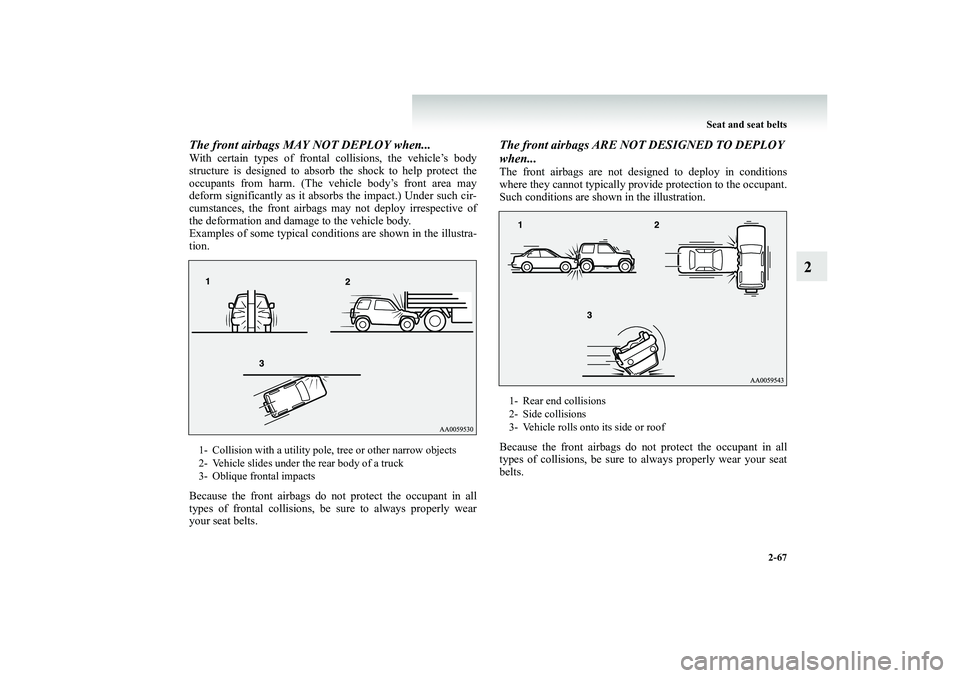
Seat and seat belts
2-67
2
The front airbags MAY NOT DEPLOY when...With certain types of frontal collisions, the vehicle’s body structure is designed to absorb the shock to help protect the occupants from harm. (The vehicle body’s front area may deform significantly as it abso
rbs the impact.) Under such cir-
cumstances, the front airbags
may not deploy irrespective of
the deformation and damage to the vehicle body. Examples of some typical conditions are shown in the illustra-tion. Because the front airbags do not
protect the occupant in all
types of frontal collisions, be sure to always properly wear your seat belts.
The front airbags ARE NOT
DESIGNED TO DEPLOY
when...The front airbags are not designed to deploy in conditions where they cannot typically provide protection to the occupant. Such conditions are shown in the illustration. Because the front airbags do not
protect the occupant in all
types of collisions, be sure to always properly wear your seatbelts.
1- Collision with a utility pole, tree or other narrow objects 2- Vehicle slides under the rear body of a truck 3- Oblique frontal impacts
1- Rear end collisions 2- Side collisions3- Vehicle rolls onto its side or roof
BK-BK2008E1ENUK.en-uk-Section5.fm Page
67 Wednesday, January 9, 2008 4:28 PM
Page 114 of 538
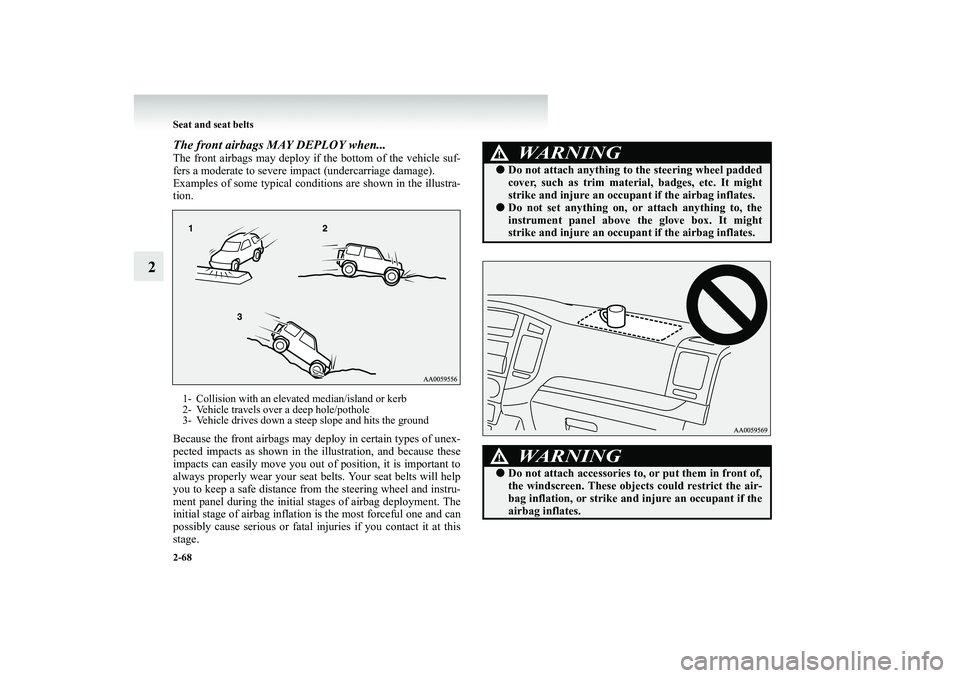
2-68 Seat and seat belts
2
The front airbags MAY DEPLOY when...The front airbags may deploy if the bottom of the vehicle suf- fers a moderate to severe impact (undercarriage damage). Examples of some typical cond
itions are shown in the illustra-
tion. Because the front airbags may de
ploy in certain types of unex-
pected impacts as shown in the
illustration, an
d because these
impacts can easily move you out of position, it is important to always properly wear your seat
belts. Your seat belts will help
you to keep a safe distance from
the steering wh
eel and instru-
ment panel during the initial stages of airbag deployment. The initial stage of airbag inflation
is the most for
ceful one and can
possibly cause serious or fatal injuries if you contact it at this stage.1- Collision with an elevated median/island or kerb 2- Vehicle travels over a deep hole/pothole 3- Vehicle drives down a steep slope and hits the ground
WARNING
!●
Do not attach anything to
the steering wheel padded
cover, such as trim materi
al, badges, etc. It might
strike and injure an occupa
nt if the airbag inflates.
●
Do not set anything on, or attach anything to, the instrument panel above the glove box. It mightstrike and injure an occupa
nt if the airbag inflates.
WARNING
!●
Do not attach accessories to, or put them in front of, the windscreen. These object
s could restrict the air-
bag inflation, or strike and
injure an occupant if the
airbag inflates.
BK-BK2008E1ENUK.en-uk-Section5.fm Page
68 Wednesday, January 9, 2008 4:28 PM
Page 115 of 538
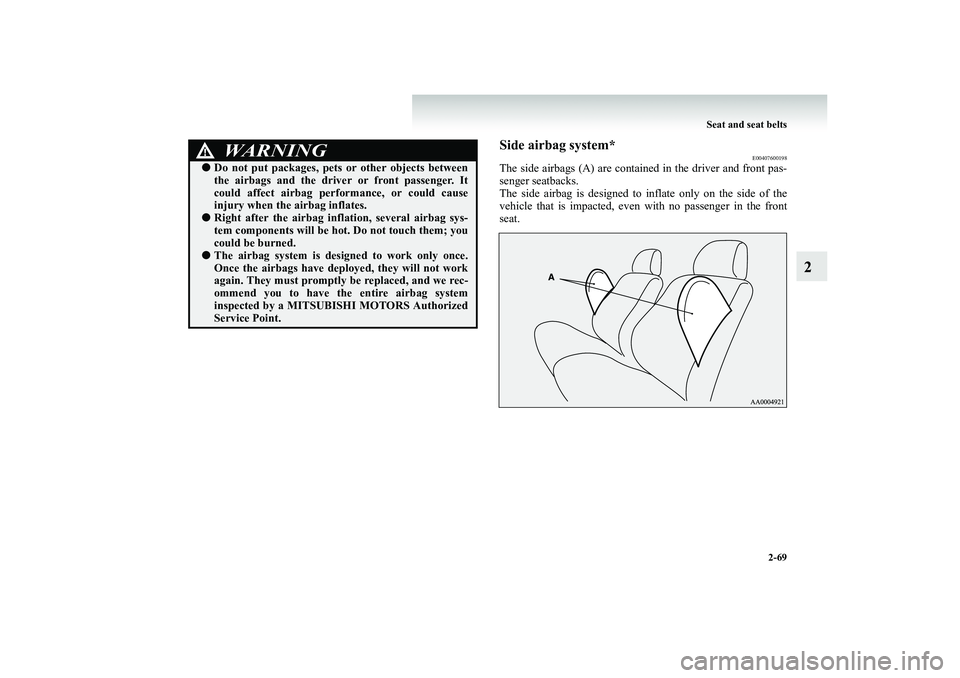
Seat and seat belts
2-69
2
Side airbag system*
E00407600198
The side airbags (A)
are contained in the
driver and front pas-
senger seatbacks. The side airbag is designed to
inflate only on th
e side of the
vehicle that is impacted, even
with no passenger in the front
seat.
●
Do not put packages, pets
or other objects between
the airbags and the driver or front passenger. It could affect airbag perfor
mance, or could cause
injury when the
airbag inflates.
●
Right after the airbag infl
ation, several airbag sys-
tem components will be ho
t. Do not touch them; you
could be burned.
●
The airbag system is designed to work only once. Once the airbags have depl
oyed, they will not work
again. They must promptly
be replaced, and we rec-
ommend you to have the entire airbag system inspected by a MITSUBIS
HI MOTORS Authorized
Service Point.WARNING
!
BK-BK2008E1ENUK.en-uk-Section5.fm Page
69 Wednesday, January 9, 2008 4:28 PM
Page 116 of 538

2-70 Seat and seat belts
2
The label shown here is attached to the seatbacks with a side airbag.
Curtain airbag system*
E00409100243
The curtain airbags are contained in the front pillars and roofside rail. The curtain
airbag is designed to
inflate only on the
side of the vehicle that is imp
acted, even with
no passenger in
the front seat or rear (3-door
models)/second (5-door models)
seat.
BK-BK2008E1ENUK.en-uk-Section5.fm Page
70 Wednesday, January 9, 2008 4:28 PM
Page 117 of 538
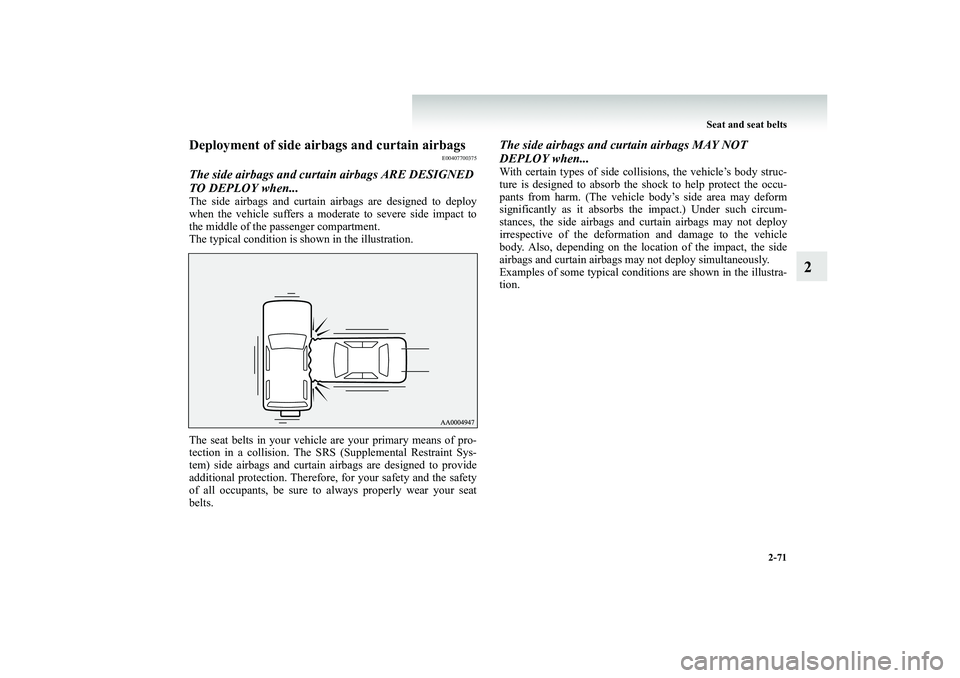
Seat and seat belts
2-71
2
Deployment of side airbags and curtain airbags
E00407700375
The side airbags and curtain airbags ARE DESIGNED TO DEPLOY when...The side airbags and curtain
airbags are designed to deploy
when the vehicle suffers a moderate to severe side impact to the middle of the passenger compartment.The typical condition is shown in the illustration. The seat belts in your vehicle are your primary means of pro- tection in a collision. The SRS (Supplemental Restraint Sys-tem) side airbags and curtain
airbags are designed to provide
additional protection. Therefore,
for your safety and the safety
of all occupants, be sure to always properly wear your seatbelts.
The side airbags and curtain airbags MAY NOT DEPLOY when...With certain types of side collisions, the vehicle’s body struc- ture is designed to absorb the
shock to help protect the occu-
pants from harm. (The vehicle body’s side area may deform significantly as it absorbs th
e impact.) Under such circum-
stances, the side airbags and
curtain airbags may not deploy
irrespective of the deformatio
n and damage to the vehicle
body. Also, depending on the location of the impact, the sideairbags and curtain airbags ma
y not deploy simultaneously.
Examples of some typical conditions are shown in the illustra- tion.
BK-BK2008E1ENUK.en-uk-Section5.fm Page
71 Wednesday, January 9, 2008 4:28 PM
Page 118 of 538
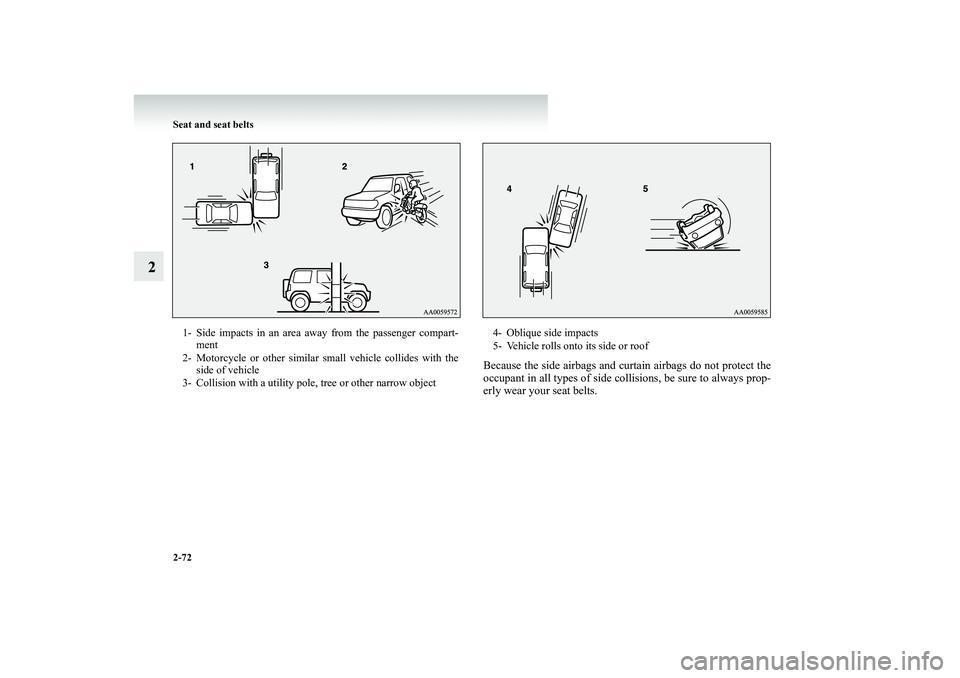
2-72 Seat and seat belts
2
Because the side airbags and curt
ain airbags do not protect the
occupant in all types of side collisions, be sure to always prop-erly wear your seat belts.
1- Side impacts in an area away from the passenger compart-
ment
2- Motorcycle or other similar small vehicle collides with the
side of vehicle
3- Collision with a utility pole, tree or other narrow object
4- Oblique side impacts 5- Vehicle rolls onto its side or roof
BK-BK2008E1ENUK.en-uk-Section5.fm Page
72 Wednesday, January 9, 2008 4:28 PM
Page 119 of 538
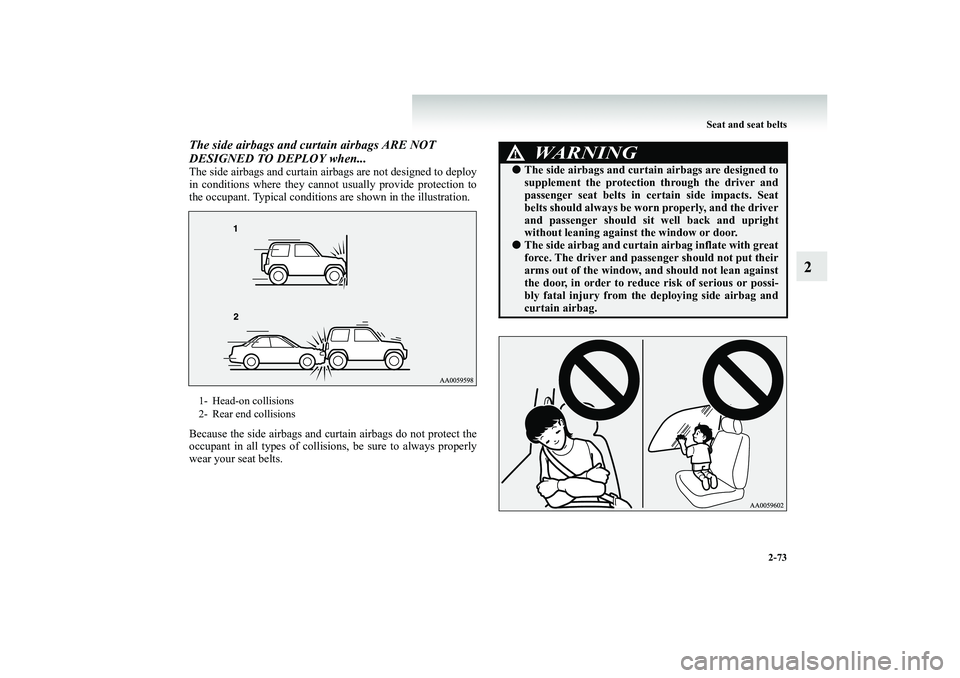
Seat and seat belts
2-73
2
The side airbags and curtain airbags ARE NOT DESIGNED TO DEPLOY when...The side airbags and curtain airb
ags are not designed to deploy
in conditions where they cannot usually provide protection to the occupant. Typical conditions
are shown in the illustration.
Because the side airbags and cu
rtain airbags do not protect the
occupant in all types of collisions, be sure to always properly wear your seat belts.1- Head-on collisions 2- Rear end collisions
WARNING
!●
The side airbags and curtai
n airbags are designed to
supplement the protection through the driver andpassenger seat belts in certain side impacts. Seat belts should always be worn properly, and the driver and passenger should sit well back and uprightwithout leaning
against the window or door.
●
The side airbag and curtain airbag inflate with great force. The driver and passenger should not put theirarms out of the window, an
d should not lean against
the door, in order to reduce
risk of serious or possi-
bly fatal injury from the deploying side airbag and curtain airbag.
BK-BK2008E1ENUK.en-uk-Section5.fm Page
73 Wednesday, January 9, 2008 4:28 PM
Page 120 of 538
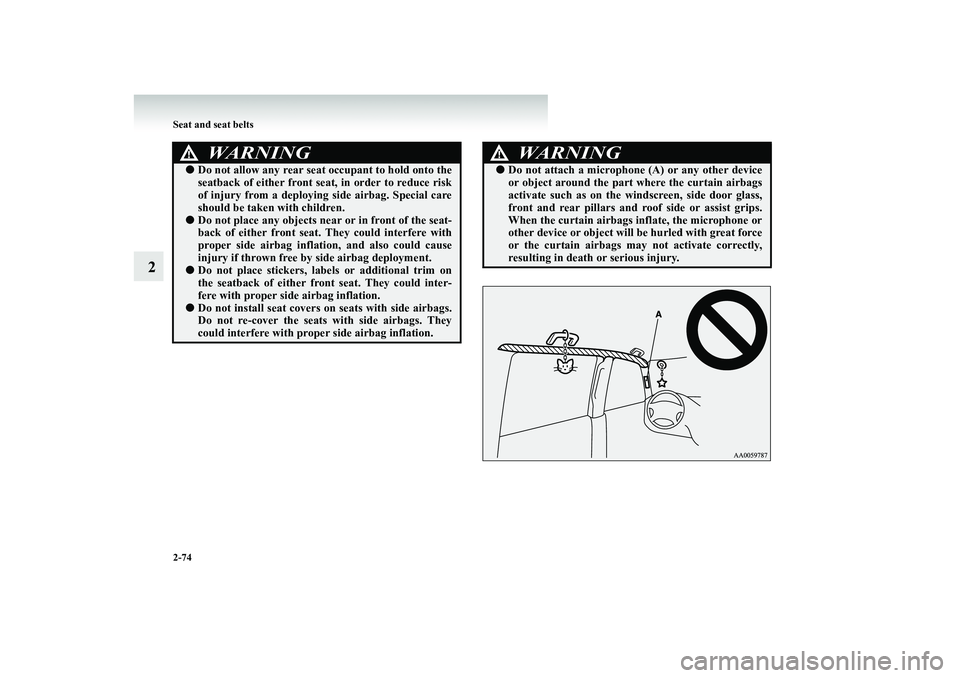
2-74 Seat and seat belts
2
WARNING
!●
Do not allow any rear seat occupant to hold onto the seatback of either front se
at, in order to reduce risk
of injury from a deploying side airbag. Special care should be taken with children.
●
Do not place any objects near or in front of the seat- back of either front seat.
They could interfere with
proper side airbag inflatio
n, and also could cause
injury if thrown free by side airbag deployment.
●
Do not place stickers, labels or additional trim on the seatback of either fron
t seat. They could inter-
fere with proper side airbag inflation.
●
Do not install seat covers
on seats with side airbags.
Do not re-cover the seats with side airbags. Theycould interfere with prop
er side airbag inflation.
WARNING
!●
Do not attach a microphone
(A) or any other device
or object around the part
where the cu
rtain airbags
activate such as on the windscreen, side door glass, front and rear pillars and roof side or assist grips. When the curtain airbags in
flate, the microphone or
other device or object will
be hurled with great force
or the curtain airbags m
ay not activate correctly,
resulting in death or serious injury.
BK-BK2008E1ENUK.en-uk-Section5.fm Page
74 Wednesday, January 9, 2008 4:28 PM